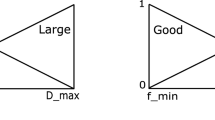Abstract
In this paper, a synergy of two mutation based immune multi-objective automatic fuzzy clustering algorithm (STMIMAFC) is proposed for the task of automatically evolving the number of clusters as well as a proper partitioning of data set. In the proposed algorithm, firstly, two new mutation operators, which are designed for the different structures of chromosomes respectively, are cooperated with each other to generate the new individuals. Secondly, we propose an exponential function based compactness validity index. The proposed method has been extensively compared with a synergy of genetic algorithm and multi-objective differential evolution, multi-objective modified differential evolution based fuzzy clustering, multi-objective clustering with automatic \(k\)-determination over a test suit of several real life data sets and synthetic data sets. Experimental results indicate the superiority of the STMIMAFC over other three compared clustering algorithms on clustering accuracy and running time.




















Similar content being viewed by others
References
Burnet FM (1957) A modification of Jerne’s theory of antibody production using the concept of clonal selection. Austral J Sci 20(1):67–69
Bezdek JC, Dunn JC (1975) Optimal fuzzy partitions: a heuristic for estimating the parameters in a mixture of normal distributions. IEEE Trans Comput Soc 24(8):835–838
Ben-Hur A, Guyon I (2003) Detecting stable clusters using principal component analysis in methods in molecular biology. In: Brownstein MJ, Kohodursky A (eds) Methods and protocols. Functional genomics. Humana press, Clifton, pp 159–182
De Castro LN, Zuben FJ (1999) Artificial immune systems: Part I Basic Theory and Applications. Technical Report-RT DCA 01/99: 90–105
De Castro LN, Timmis J (2002) Artificial immune systems, a new computational intelligence approach. Springer, Berlin
Du HF, Jiao LC, Wang SA (2002) Clonal operator and antibody clone algorithms. In: Proceedings of the first international conference on machine learning and cybernetics, pp 506–510
Demsar J (2006) Statistical comparisons of classifiers over multiple data sets. J Mach Learn Res 7:1–30
Das S, Abraham A, Konar A (2008) Automatic clustering using an improved differential evolution algorithm. IEEE Trans Syst Man Cybern A Syst Hum 38(1):218–237
Dasgupta D, Yu S, Nino F (2011) Recent advances in artificial immune systems: models and applications. Appl Soft Comput 11(2):1574–1587
Fei W, Ping L, Arnd CK et al (2012) Improving clustering by learning a bi-stochastic data similarity matrix. Knowl Inf Syst 32(2):351–382
Garcia S, Molina D, Lozano M et al (2009) A study on the use of non-parametric tests for analyzing the evolutionary algorithms’ behavior: a case study on the CEC’2005 special session on real parameter optimization. J Heuristics 15:617–644
Hubert A (1985) Comparing partitions. J Classif 2(1):193–198
Jain AK, Murty MN, Flynn PJ (1999) Data clustering: a review. ACM Comput Surv 31(3):264–323
Julia H, Joshua K (2006) An evolutionary approach to multi-objective clustering. IEEE Trans Evolut Comput 11(1):56–76
Kwon SH (1998) Cluster validity index for fuzzy clustering. Electron Lett 34(22):2176–2177
Kundu D, Suresh K, Ghosh S et al (2009) Automatic clustering using a synergy of genetic algorithm and multi-objective differential evolution. In: Corchado E et al (eds) Hybrid artificial intelligence systems. lecture notes in computer science, vol 5572. Springer, Berlin, pp 177–186
Katharina M, Andreas K, Michael W et al (2012) Multi-objective frequent termset clustering. Knowl Inf Syst 30(3):715–738
Liu RC, Zhang XR, Yang N, Lei QF, Jiao LC (2012) Immunodomaince based clonal selection clustering algorithm source. Appl Soft Comput 12(1):302–312
Liu R, Jiao L, Zhang X et al (2012) Gene transposon based clone selection algorithm for automatic clustering. Inf Sci 204:1–22
Maulik U, Bandyopadhyay S (2003) Fuzzy partitioning using a real-coded variable-length genetic algorithm for pixel classification. IEEE Trans Geosci Remote Sens 41(5):1075–1081
Maulik U, Saha I (2010) Automatic fuzzy clustering using modifed differential evolution for image classification. IEEE Trans Geosci Remote Sens 48(9):3503–3510
Nizar B, Djemel Z (2012) A countable infinite mixture model for clustering and feature selection. Knowl Inf Syst 33(2):351–370
Omran M, Salman A, Engelbrecht A (2006) Dynamic clustering using particle swarm optimization with application in unsupervised image classification. Pattern Anal Appl 8(4):332–344
Pal NR, Pal SK (1992) Some properties of the exponential entropy. Inform Sci 66(1–2):119–137
Pal NR, Pal SK (1993) A review on image segmentation techniques. Pattern Recognit 26(9):1277–1294
Pal NR, Bezdek JC (1995) On cluster validity for the fuzzy c-means model. IEEE Trans Fuzzy Syst 3(3):370–379
Pakhira MK, Bandyopadhyay S, Maulik U (2004) Validity index for crisp and fuzzy clusters. Pattern Recognit 37(3):487–501 Pergamon Press, New York
Rand W (1971) Objective criteria for the evaluation of clustering methods. J Am Stat Assoc 66(336):846–850
Storn R, Price K (1995) Differential evolutiona simple and efficient adaptive scheme for global optimization over continuous spaces. Tech Rep. International Computer Science Institute, pp 22–25
Saha S, Bandyopadhyay S (2010) A new multiobjective clustering technique based on the concepts of stability and symmetry. Knowl Inf Syst 23(1):1–27
Saha I, Maulikb U, Plewczynski D (2011) A new multi-objective technique for differential fuzzy clustering. Appl Soft Comput 11(2):2765–2776
Xie XL, Beni G (1991) A validity measure for fuzzy clustering. IEEE Trans Pattern Anal Mach Intell 13(8):841–847
Acknowledgments
The authors would like to thank the editor and the reviewers for helpful comments that greatly improved the paper. This work was supported by the National Natural Science Foundation of China (Nos. 61373111, 61272279, 61103119 and 61203303); the Fundamental Research Funds for the Central Universities (Nos. K50511020014, K5051302084, K50510020011, K5051302049, and K5051302023); and the Provincial Natural Science Foundation of Shaanxi of China (No. 2014JM8321).
Author information
Authors and Affiliations
Corresponding author
Rights and permissions
About this article
Cite this article
Liu, R., Zhang, L., Li, B. et al. Synergy of two mutations based immune multi-objective automatic fuzzy clustering algorithm. Knowl Inf Syst 45, 133–157 (2015). https://doi.org/10.1007/s10115-014-0805-4
Received:
Revised:
Accepted:
Published:
Issue Date:
DOI: https://doi.org/10.1007/s10115-014-0805-4




